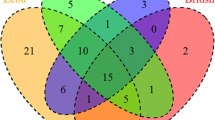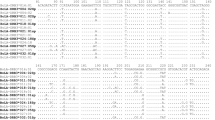Abstract
Intrabreed and interbreed variation of BOLA-DRB3 exon 2 (BOLA-DRB3.2) was for the first time studied in the Kostroma and Yaroslavl cattle breeds by PCR-RFLP. These breeds are among the best Russian breeds and were developed as dairy–beef and dairy cattle, respectively. Twenty-nine alleles were observed in five Kostroma samples, and 14 of them proved unique in comparison with two Yaroslavl samples, in which 25 alleles were detected, and 10 of them were unique. The total frequency of bovine leukemia virus (BLV) resistance alleles (*11, *23, and *28) was 23.2% in the Kostroma, while the total frequency of BLV susceptibility alleles (*8, *16, *22, *24) was low, 8.4%. The frequencies were 25.8 and 30.1%, respectively, in Yaroslavl cattle. Testing Hardy–Weinberg equilibrium revealed a significant deficit of heterozygotes: the observed (Ho) and expected (He) heterozygosities were, respectively, 0.734 and 0.859 in Kostroma cattle and 0.613 and 0.886 in Yaroslavl cattle. The intrabreed differentiation (FST) in the Kostroma (4.5%, P = 0.001) was substantially higher than in the Yaroslavl (0.5%, P = 0.158), between the two breeds was 8.2% (P = 0.001). The Bayesian clustering approach showed an intrabreed structure for each of the breeds, with the most probable number of clusters being 2 in the Kostroma and 3 in the Yaroslavl. The structure observed in the Kostroma remained the same when the breed was analyzed together with six additional breeds. Our data provide important clues toward the understanding of the genetic structure of indigenous breeds.






Similar content being viewed by others
Data availability
Data are presented in the manuscript.
References
Agyemang K (2005) Trypanotolerant livestock in the context of trypanosomiasis intervention strategies, vol 7. Food & Agriculture Org, Rome
Altukhov YuP, Salmenkova EA, Kurbatova OL, Pobedonostseva EYu, Politov DV, Evsyukov AN, Zhukova OV, Zakharov IA, Moiseeva IG, Stolpovsky YuA, Pukhal’skiy VA, Pomortsev AA, Upel’niek VP, Kalabushkin BA (2004) Dinamika populyatsionnykh genofondov zhivotnykh [Dynamics of population animal gene pools] Pod red. Altukhova YuP [In: Altukhov YuP (ed)] Dinamika populyatsionnykh genofondov pri antropogennykh vozdeystviyakh [The dynamics of population gene pools under human actions], Nauka Publ, Moscow, pp 110-294 (in Russian)
Behl JD, Verma NK, Tyagi N, Mishra P, Behl R, Joshi BK (2012) The major histocompatibility complex in bovines: a review. ISRN Vet Sci 2012:1–12. https://doi.org/10.5402/2012/872710
Benjamini Y, Hochberg Y (1995) Controlling the false discovery rate: a practical and powerful approach to multiple testing. J R Stat Soc Ser B Stat Methodol 57:289–300. https://doi.org/10.1111/j.2517-6161.1995.tb02031.x
Evanno G, Regnaut S, Goudet J (2005) Detecting the number of clusters of individuals using the software STRUCTURE: a simulation study. Mol Ecol 14:2611–2620. https://doi.org/10.1111/j.1365-294X.2005.02553.x
FAO (1989) Animal genetic resources of the USSR. In: Dmitriev NG, Ernst LK (eds) Animal production and health (issue 65). FAO, Rome
FAO (2007) Section E. Animal genetic resources and resistance to disease. In: Rischkowsky B, Pilling D (eds) The State of the World’s Animal Genetic Resources for Food and Agriculture. Food and Agriculture Organization of the United Nations, Rome
FAO (2010) In: Hiemstra SJ, de Haas Y, MaKi-Tanila A, Gandini G (eds) Local cattle breeds in Europe: development of policies and strategies for self-sustaining breeds. Wageningen Academic Pub, Wageningen
Giovambattista G, Takeshima SN, Ripoli MV, Matsumoto Y, Franco LA, Saito H, Onuma M, Aida Y (2013) Characterization of bovine MHC DRB3 diversity in Latin American Creole cattle breeds. Gene 519:150–158. https://doi.org/10.1016/j.gene.2013.01.002
Hernández-Herrera D, Posso-Terranova A, Muñoz-Florez J, Giovambattista G, Álvarez-Franco L (2013) Polymorphism of BOLA-DRB3.2* gene in creole Colombian breeds. Rev MVZ Córdoba 18:3665–3671. https://doi.org/10.21897/rmvz.133
Lazebnaya IV, Lazebny OE, Sulimova GE (2010) Study of genetic variation in Yakutian cattle (Bos taurus L.) using the prolactin bPRL, growth hormone bGH, and transcription factor bPit-1 genes. Russ J Genet 46:377–380
Lazebnaya IV, Lazebny OE, Khatami SR, Sulimova GE (2013) Use of the bovine prolactin gene (bPRL) for estimating genetic variation and milk production in aboriginal Russian breeds of Bos taurus. In: Nagy GM, Toth BE (eds) Prolactin. InTech, Rijeka, Croatia, pp 35–52. https://doi.org/10.5772/54756
Lazebnaya IV, Perchun AV, Lhasaranov BB, Lazebny OE, Stolpovskiy YA (2018) Analysis of GH1, GHR and PRL gene polymorphisms for estimation of the genetic diversity of Buryat and Altai cattle breeds. Vavilov J Genet Breed 22:734–741. https://doi.org/10.18699/VJ18.417
Mapiye C, Chikwanha OC, Chimonyo M, Dzama K (2019) Strategies for sustainable use of indigenous cattle genetic resources in Southern Africa. Diversity 11:214. https://doi.org/10.3390/d11110214
Martínez AM, Gama LT, Cañón J, Ginja C, Delgado JV, Dunner S, Landi V, Martín-Burriel I, Penedo MC, Rodellar C, Vega-Pla JL, Acosta A, Alvarez LA, Camacho E, Cortés O, Marques JR, Martínez R, Martínez RD, Melucci L, Martínez-Velázquez G, Muñoz JE, Postiglioni A, Quiroz J, Sponenberg P, Uffo O, Villalobos A, Zambrano D, Zaragoza P (2012) Genetic footprints of Iberian cattle in America 500 years after the arrival of Columbus. PLoS One 7:e49066. https://doi.org/10.1371/journal.pone.0049066
Miyasaka T, Takeshima SN, Jimba M, Matsumoto Y, Kobayashi N, Matsuhashi T, Sentsui H, Aida Y (2013) Identification of bovine leukocyte antigen class II haplotypes associated with variations in bovine leukemia virus proviral load in Japanese Black cattle. Tissue Antigens 81:72–82. https://doi.org/10.1111/tan.1204
Mohammadabadi MR, Shaikhaev GO, Sulimova GE, Rahman O, Mozafari MR (2004) Detection of bovine leukemia virus proviral DNA in Yaroslavl, Mongolian and Black Pied cattle by PCR. Cell Mol Biol Lett 9:766–768
Mosafer J, Nassiry MR (2005) Identification of bovine lymphocyte antigen DRB3.2 alleles in Iranian Golpayegani cattle by DNA test. Asian-Australas J Anim Sci 18:1691–1695. https://doi.org/10.5713/ajas.2005.1691
Nei M (1978) Estimation of average heterozygosity and genetic distance from a small number of individuals. Genetics 76:379–390
Oprzadek JM, Brzozowska AM, Urtnowski P, Rutkowska K, Lukaszewicz M (2018) Association of BOLA-DRB3 genotype with somatic cell count in milk of Polish Holstein cattle. R Bras Zootec 47. https://doi.org/10.1590/rbz4720150290
Peakall R, Smouse PE (2012) GenAlEx tutorials-part 2: genetic distance and analysis of molecular variance (AMOVA). Bioinformatics 28:2537–2539. https://doi.org/10.1093/bioinformatics/bts460
Pritchard JK, Stephens M, Donnelly P (2000) Inference of population structure using multilocus genotype data. Genetics 155:945–959
Ruzina MN, Shtyfurko TA, Mohammadabadi MR, Gendzhieva OB, Tsedev T, Sulimova GE (2010) Polymorphism of the BOLA-DRB3 gene in the Mongolian, Kalmyk, and Yakut cattle breeds. Russ J Genet 46:456–463. https://doi.org/10.1134/S1022795410040113
Shabtay A (2015) Adaptive traits of indigenous cattle breeds: the Mediterranean Baladi as a case study. Meat Sci 109:27–39. https://doi.org/10.1016/j.meatsci.2015.05.014
StatSoft, Inc. (2011) STATISTICA for Windows [Computer program manual]. StatSoft, Inc., Tulsa
Sulimova GE, Lazebnaja IV, Perchun AV, Voronkova VN, Ruzina MN, Badin GA (2011) Uniqueness of Kostroma breed of cattle from a position of molecular genetics. Adv Sci Technol Agro-Industr Complex 9:52–54
Sulimova GE, Lazebnaya IV, Ruzina MN, Belokurov SG, Perchun AV (2014) Polymorphism of the BOLA-DRB3 gene in bull sires of the Kostroma breed as genetic factor of the resistance to leukemia. J Vet Dent 6:24–27
Takeshima SN, Giovambattista G, Okimoto N, Matsumoto Y, Rogberg-Muñoz A, Acosta TJ, Onuma M, Aida Y (2015) Characterization of bovine MHC class II DRB3 diversity in South American Holstein cattle populations. Tissue Antigens 86:419–430. https://doi.org/10.1111/tan.12692
Udina IG, Karamysheva EE, Turkova SO, Orlova AR, Sulimova GE (2003) Genetic mechanisms of resistance and susceptibility to leukemia in Ayrshire and black pied cattle breeds determined by allelic distribution of gene BOLA-DRB3. Russ J Genet 39:306–317. https://doi.org/10.1023/A:1023279818867
Yurchenko A, Yudin N, Aitnazarov R, Plyusnina A, Brukhin V, Soloshenko V, Lhasaranov B, Popov R, Paronyan IA, Plemyashov KV, Larkin DM (2018) Genome-wide genoty** uncovers genetic profiles and history of the Russian cattle breeds. Heredity 20:125–137. https://doi.org/10.1038/s41437-017-0024-3
Funding
This work has been funded by government program of basic research in the Vavilov Institute of General Genetics of the Russian Academy of Sciences in 2020, 0112-2016-0003, and partly by the Russian Science Foundation under grant 19-76-20061. The work of OEL was conducted under the IDB RAS Government basic research program in 2020, № 0108-2019-0007.
Author information
Authors and Affiliations
Contributions
Irina V. Lazebnaya contributed to the study conception and design. Sample collection and genoty** were performed by Aleksey V. Perchun and Irina V. Lazebnaya. Data analysis was conducted by Irina V. Lazebnaya and Oleg E. Lazebny. The first draft of the manuscript was written by Irina V. Lazebnaya, and all of the authors commented on previous versions of the manuscript.
Corresponding author
Ethics declarations
Conflict of interest
The authors declare that they have no conflict of interest.
Ethics approval
Biological samples were collected during routine veterinary checkups in the framework of official health control programs and with the agreement of breeders.
Consent to participate
Not applicable.
Consent for publication
All authors read and approved the manuscript.
Additional information
Publisher’s note
Springer Nature remains neutral with regard to jurisdictional claims in published maps and institutional affiliations.
Rights and permissions
About this article
Cite this article
Lazebnaya, I.V., Perchun, A.V. & Lazebny, O.E. Intrabreed and interbreed variation of the BOLA-DRB3.2 gene in the Kostroma and Yaroslavl indigenous Russian cattle breeds. Immunogenetics 72, 355–366 (2020). https://doi.org/10.1007/s00251-020-01173-7
Received:
Accepted:
Published:
Issue Date:
DOI: https://doi.org/10.1007/s00251-020-01173-7




